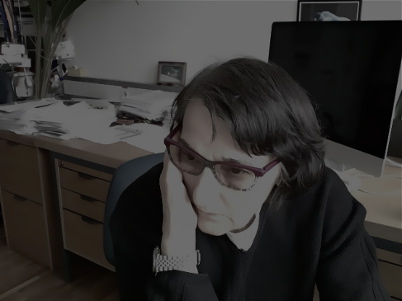 |
| Home | Research | Students | Projects | MyWorkshops | Editor | Teaching | Jobs | inBooks |
| NETWORKS | NETs_GALLERY | NANOSCALE_SYSTEMS | SOLSTICE2014_Conference |
|
BY SUBJECT:
|
| CV++ |
| Publications/bySubject |
| Conference Talks CS |
| Cellular Automata |
| Barkhausen Noise |
| Self-Assembled Nano-Materials |
| Multi-Brain Networks |
| Epidemics: Modeling SARS-CoV-2 |
| Agent-Based Models & Sociodynamics |
| Complex Networks |
| Renormalization Group |
| Orientational Glasses |
| Quantum SpinGlasses |
|
|
|
Review Articles & Book Chapters
|
| B. Tadic, G.J. Rodgers and S. Thurner Transport on Complex Networks: Flow, Jamming & Optimization, Int. J. Bifurcation and Chaos, Vol. 17, Issue 7, July 2007 |
| B. Tadic, From Microscopic Rules to Emergent Cooperativity in Large-Scale Patterns, Chapter in Book Systems Self-Assembly: Multidisciplinary Snapshots , Eds. N. Krasnogor et al., Elsevier, publ. March 2008: Link to publisher's page here... |
| M.O. Blunt, A. Stannard, E. Pauliac-Vaujour, C.P. Martin, I. Vancea, M. Suvakov, U. Thiele, B. Tadic and P. Moriarty, Patterns and Pathways in Nanoparticle Selforganization, Chapter 8 in Oxford Handbook of Nanoscience and Technology, Volume 1: Basic Aspects, Eds. A.V. Narlikar and Y.Y. Wu, Oxford University Press, ISBN 978-0-19-953304-6 |
| M. Suvakov and B. Tadic, Modeling collective charge transport in nanoparticle assemblies, TOPICAL REVIEW, J. Physics: Condensed Matter, Vol. 22, No. 16 (2010) |
| M.Mitrovic and B. Tadic, Emergence and Structure of Cybercommunities, Chapter in Handbook of Optimization in Complex Networks Theory and Applications , Eds. M.T. Thai and P. Pardalos, Springer "Optimization and its Applications" , Vol.57, Part 2, pp. 209--227, DOI:10.1007/978-1-4614-0754-6_8 , January 2012, ISBN 978-0-19-953304-6 |
| B. Tadic recent-Abstracts15-book |
| B. Tadic, R. Melnik ABM -Epidemics: medRxiv 2020 |
|
|
|
RESTRICTED:
|
| Music |
| PhotoGraphic |
| COST_MP0801 WebPage |
|
Description:
Complex patterns of links (Networks), Domain Walls,
or assemblies of Nanoscale objects emerge in non-equilibrium
dynamic processes with Driving, Constraints,
and Self- Organization. We explore how such complex patterns have evolved in nature and in man made techno-social systems
or can be assembled in laboratory into organized functional structures, and how the structural complexity affects their physical properties and function.
 Higher-Order Connectivity of Brain
Graphs---Simplicial Complexes structure of human brain,
studied from the empirical data of Human Connectome Project and
Social Neuroscience hyperscanning data.
M. Andjelkovic, B. Tadic, R. Melnik,
The topology of higher-order complexes associated with brain hubs in
human connectomes, Scientific Reports 10:17320 (2020)
B. Tadic, M. Chutani, N. Gupte, Multiscale fractality in partial synchronization on simplicial complexes around brain hubs Chaos, Solitons and Fractals 160, 112201 (2022)
Higher-Order Connectivity of Brain
Graphs---Simplicial Complexes structure of human brain,
studied from the empirical data of Human Connectome Project and
Social Neuroscience hyperscanning data.
M. Andjelkovic, B. Tadic, R. Melnik,
The topology of higher-order complexes associated with brain hubs in
human connectomes, Scientific Reports 10:17320 (2020)
B. Tadic, M. Chutani, N. Gupte, Multiscale fractality in partial synchronization on simplicial complexes around brain hubs Chaos, Solitons and Fractals 160, 112201 (2022)
 Bottom-up Architecture of Simplicial Complexes---Modelling self-assembly of complex nano-networks by aggregation of simplexes; Simulations of the field-driven magnetisation reversal processes on them.
B. Tadic, M. Suvakov, M. Andjelkovic, G.J. Rodgers,
Large-scale influence of defect bonds in geometrically constrained
self-assembly,
Physical Review E 102:032307 (2020); Magnetisation processes in
geometrically frustrated spin networks with self-assembled cliques,
Entropy 22(3):336 (2020)
B. Tadic, R. Melnik, Fundamental interactions in self-organised critical dynamics on higher order networks topical review The European Physical Journal B 97, art.n.68 (2024)
B. Tadic, R. Pirc, Ising-spin networks with competing geometric interactions: a new perspective for investigating emergent phenomena in complex materials, topical review The European Physical Journal B 98, art.n.115 (2025)
Bottom-up Architecture of Simplicial Complexes---Modelling self-assembly of complex nano-networks by aggregation of simplexes; Simulations of the field-driven magnetisation reversal processes on them.
B. Tadic, M. Suvakov, M. Andjelkovic, G.J. Rodgers,
Large-scale influence of defect bonds in geometrically constrained
self-assembly,
Physical Review E 102:032307 (2020); Magnetisation processes in
geometrically frustrated spin networks with self-assembled cliques,
Entropy 22(3):336 (2020)
B. Tadic, R. Melnik, Fundamental interactions in self-organised critical dynamics on higher order networks topical review The European Physical Journal B 97, art.n.68 (2024)
B. Tadic, R. Pirc, Ising-spin networks with competing geometric interactions: a new perspective for investigating emergent phenomena in complex materials, topical review The European Physical Journal B 98, art.n.115 (2025)
Research Fields: Network ResearchHighlights ONLINE SOCIAL DYNAMICS(see our publications in CYBEREMOTIONS Project update...) ☆ |
#